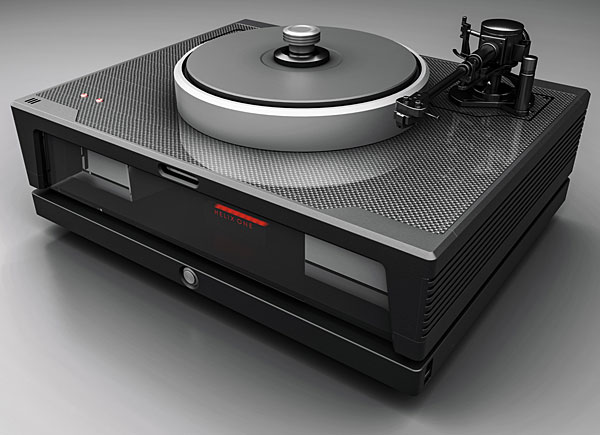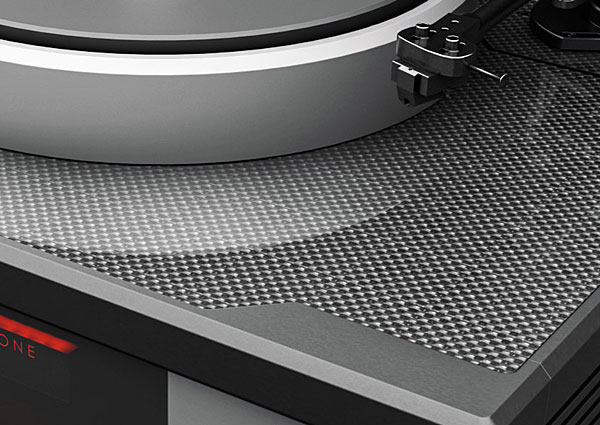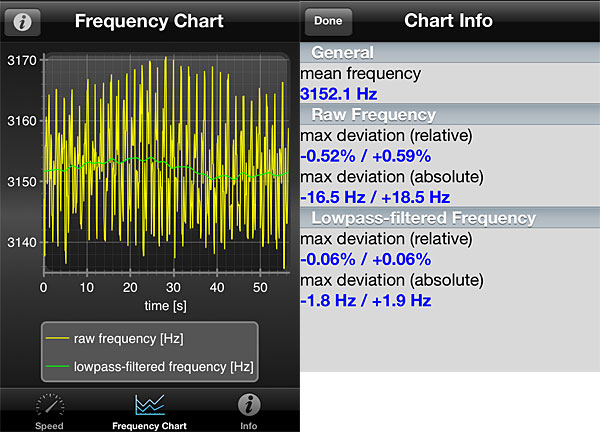| Columns Retired Columns & Blogs |
Cool! No listening tests or conclusions. The ultimate objectivist review for a turntable.
Or a simple glitch in the web presentation... :8^)
The original Helix One also incorporated most of these design details, but some of them—the plates, for example—are said to have been improved. The Mk2 differs in a few other significant ways, beginning with a higher-performance power supply, which is no longer located in an outboard, amplifier-sized chassis but rather housed in a sleek new "PowerBase," upon which the massive turntable chassis rests. Newly developed RF-absorption technology is said to have been incorporated into the PowerBase to prevent noise and electronic interference from entering the signal path.
The PowerBase's large, center-mounted pushbutton switch is for a future, retrofittable vacuum hold-down feature that was promised at the time of the original Helix One review. I'm not sure what's holding it up, but if you buy a Helix One Mk2 now, you probably should not expect the vacuum hold-down update to follow quickly (though if it does, all the better).
The new 'table retains a somewhat simplified version of the unique "floating" armboard technology originally found in Mark Döhmann's earlier designs, which physically isolates the board while maintaining (it is claimed) positional stability. The main armboard is of a new energy-diffusing composite material developed by an American military supplier and used for bulletproofing. One such board comes standard with the Mk2; the second armboard is made of aluminum. Both positions can accommodate arms up to 12" in length.
The motor is an all-new, custom-designed, Swiss-manufactured, high-torque design, controlled by a custom, software-based, closed-loop servo control system located in the PowerBase, which monitors and calibrates speed more than 130,000 times per second. The original Helix One's motor occasionally developed reliability and noise issues. Mr. Döhmann ended up traveling to customers' homes to replace them.

Also new is a rear-panel–mounted pushbutton Up/Down speed-adjustment feature. The original turntable's speed was factory-set, though adjustable via computer, remotely over the Internet. The Mk2's motor can also be adjusted and diagnosed over the Internet.
The platter-and-bearing system appear identical to the original's, a 30lb triple-sandwich platter of a nonferrous alloy layered with an "engineered thermoplastic" that's balanced and shaped to accommodate lead-in groove and record label areas, topped with a permanent, thin damping mat. The spindle is of brass, while the bearing features a single ceramic ball and a thrust pad located at the squat bearing's bottom, which puts the point of rotation smartly centered within the platter.
Platter drive is via a dual-groove machined-aluminum pulley and platter, over which fits a pair of dissimilar-diameter O-rings, each with a different degree of hardness so that each "beats" differently, with the motor-control system doing the final smoothing.
Other new features include revised electronics designed to automatically turn off when not in use, a new lighting-control system, and a stabilizer designed to minimize Minus K suspension bounce when flipping over a record. Gone are the original Helix One's brass balancing weights; they're no longer necessary, thanks to a suspension design change.
The Helix One Mk2 is a big turntable: 23.6" × 18.9" × 9.8". It looks and "handles" like no other turntable, and its design has almost nothing to do with the hypothetical "basic" turntable described in my opening paragraph. Not everyone I know likes the look, but I surely do.
Supplied in a smooth, satiny-black anodized-aluminum finish, the standard 'table costs $49,000, or $55,600 in plated nickel and titanium, the coating done by a company that plates military parts for fighter jets. The two versions are said to be sonically identical.
Döhmann can supply armboards cut for just about any tonearm and recommends, for starters, the Thrax-manufactured Schröder CB arm, which costs $5500 for the 9" version and $6000 for the 11" one. Döhmann supplied me with a 9" CB arm with a carbon-fiber armtube, which I used for part of the review. I also used my SAT CF1-09, for which I borrowed an armboard.

This is not a Schröder arm review, but I'm well familiar with the CB, having used one on the original Helix One as well as for my OMA plinth/Technics SP10R review in the February 2019 Stereophile. Though somewhat spartan—there's no arm rest, which designer Frank Schröder claims negatively affects sonics—it offers complete adjustability and performs well above its reasonable price point. It's a really fine sounding, sonically "tunable" arm.
Setup and use
A friend helped hoist the turntable's PowerBase and main chassis onto my HRS SXR Signature rack. The entire assemblage weighs around 200lb—the precise weight is not specified, but buyers are advised to place it on a platform capable of supporting 210lb. I'll skip the setup details, since that will likely be done by a dealer, other than to say that, though somewhat unusual, it's a straightforward process thanks to an excellent instruction manual that includes photos.
Using the Helix One Mk2 is equally uncomplicated; that said, when putting on and removing a record and screwing on and off the record weight, you have to get used to the Minus K isolation system's "bounce." It feels the same as it did on the original Helix One. Some people will never get used to it and won't like it. It didn't bother me. The high-torque motor gets the platter up to speed quickly. One illuminated button selects 33.3rpm, the other 45, and that's all there is to it once you've adjusted the Minus K's very sensitive "float height" using the rear-mounted adjustment knob.
The Mk2's speed measurements were somewhat disappointing compared to the original Helix One. The original's low-pass–filtered relative maximum deviation was –0.03%, +0.02%, while the low-pass–filtered absolute maximum deviation was –0.9Hz, +0.8Hz. Those were very good numbers. This time, the low-pass–filtered maximum deviation numbers were ±0.06 (fig.1): still good, but two or three times worse, while the absolute low-pass–filtered maximum deviation was –1.8Hz, +1.9Hz, which is about two times worse.

I made those measurements with the Minus K system both active and disabled, and got similar results. I'm not sure what accounts for this—perhaps something got bumped in shipping? Hopefully, the manufacturer will get the unit back in time to inspect, measure, and explain.
In any case, this minor drop in speed consistency, measured late in the review process, was not noted during the months I spent listening to the Helix One Mk2—even on long, sustained notes.

Cool! No listening tests or conclusions. The ultimate objectivist review for a turntable.
Or a simple glitch in the web presentation... :8^)

You must have missed the subjective comments on page 3. I guess the Caliburn is still the superior sounding 'table.
The only objective part in the whole review was the graph of speed stability. To that, most "objectivists" would say: "That's some jittery hardware!" :-)

May be that hardware needs one or two jitter repelling, 'JitterBugs' :-) ........

...this is the turntable for you!
So this is better than a $500 computer hooked up to a Benchmark DAC3 exactly how?
Sorry, that was a dick question, but I do hope that you realize that this turntable is absurd.
This is akin to our glorious leader pushing incandescent light bulbs.
The only thing I can say is, "Enjoy the obsolescence."
Stay Corona free, baby!

You also harass analog reviewers from other magazines and websites. I've visited your "website". You are a sad, pathetic wanker who has nothing better to do than post your kind of bitter nonsense. And yes we do enjoy our vinyl, which had its best sales year since the 1990s. And most of us also enjoy our digital. Clearly you don't enjoy your life or you'd not waste your time and ours with your bitterness.

For some reason, most of the content on page 3 was missing at first - probably not entirely uploaded at that point. All that had been presented in the first two pages was some measurements and a factual description of the product. Almost no opinion, informed or otherwise. Hence, only objective material.
That was the joke, as I suggested in my second paragraph. The actual content for page 3 is now there.
As for objectivists, I will leave my opinion off these pages.

Your admiring opinions about the objectivists is welcome in these pages :-) ........

... of this $50K turntable meet - let alone surpass - that of a $500 Onkyo?
https://www.analogplanet.com/content/onkyos-cp-1050-direct-drive-turntable-offers-extraordinary-speed-stability-attractive-retro

Enquiring minds want to know :-) ........

with a surprise upper-register, single- chord attack followed by a flourish of gentle note-tickling. (There's probably a musical term for that that I don't know.) It all rang timbrally, texturally, and dynamically true
Oh really ;)

This TT (and the Helix 2 before it in AnalogPlanet) continue to get rave, technologically-rapt reviews, yet I would contend that Dohmann & Co. are not using the MinusK platform in the manner in which it was designed for. Both in this review and Mikey's Munich 2015 video (https://www.youtube.com/watch?v=LRGLXOFQKb4) it is stated -- extraordinarily -- that despite the amazing Minus K tech incorporated in this TT Dohmann puts the motor ON the subchassis. Listen to the video at 4'.05'', where the Dohmann rep describes the motor being on the same plane and "...moving with the suspension". He describes the Helix as being effectively immune-to and isolated-from "...ground-based vibration", but this is irrelevant as, while the Minus K's usage in SEM and EFM microscopy attests to the utility of this anti-vibration tech, the principal source of vibration in a turntable is not 'ground-based' but WITHIN the turntable, i.e., the motor, and thus this groundbreaking tech is bypassed to a greater or lesser degree.
Watch the appropriately-named video 'Famous Minus K Wine Glass Demo Described' (https://www.youtube.com/watch?v=evAx-1rv4lQ), and marvel at how how this extraordinary device isolates a filled wine-glass placed upon it from the stated earthquake-level vibration beneath it. Then wonder how this amazing device would work if the vibration source were placed UPON the Minus K along with that wine glass, as in the Dohmann Helix.
Show me a Minus K video with both the undisturbed wine glass AND the vibration source on the Minus K and I'll buy it, but this Dohmann TT is not, per the Company rep's description and Mikey's description herein, implementing the Minus K in the way that it was designed to be. I know that Mikey has a bee in his bonnet in regard to his 'porch-glider effect' (i.e., the notional -- but yet to be demonstrated -- belt-communicated speed variations that result from a motor not mounted on the subchassis), but I would contend that this effect, whether audible or measurable, is as nothing compared to the piggybacking of spurious 50/60 Hz motor noise on the audio signal that results from mounting the motor on the same surface as the transducer. The $3.5K Rega Planar 10 betrays itself in this regard through the application of a stethoscope, and while the Helix 1 is undoubtedly much better than even Rega's best singing-along-to-itself TT this tech deserves to be better implemented.
As I said in a comment on the Rega TT review (and Herb chimed in in-support of), it's time to test TTs with an accelerometer applied to the arm base to see just how isolating or not these various mechanical devices are. A stethoscope is a great idea and a good-start, but it's time to get systematic about this -- particularly when sums of $50k are being asked for.
A motor plonked on the subchassis that bears both the platter and arm = the Rega model of isolation. Jog-on Mr D...

Egads, with 200 lbs of mass these guys could significantly minimize the affects/effects of tiny stray environmental forces on the platter/stylus workings.
It's basic physics : add mass to lower resonance.
Anyone can do this.
Tony in Venice

Egads, with 200 lbs of mass these guys could significantly minimize the affects/effects of tiny stray environmental forces on the platter/stylus workings.
This is not true, and has been proven demonstrably by Mr. Gandy. Mass is a piss poor excuse for good engineering, and only stores low frequency energy - the harmonics of which destroy HF clarity. If the mass is part of OTHER engineering goals - the point of which in this case seems to be creating a "massless" plinth system, then it is, in fact, trying to serve in a rather unique way, Mr. Gandy's theory about plinth design. If you house a low pressure air bladder support in a concrete container - if for looks alone OR if you are convinced that's the perfect version of constrained layer damping, you're STILL resting your plinth/bearing on AIR. You see what I'm saying and why your statement is silly? I'm not trying to start a pissing match at all - just trying to show a flaw in your logic. The fact that so many people are chasing Mr. Gandy's key ideas by way of so many different designs should tell you all you really need to know about the flaws of high mass designs.

Are you a Physics Understudy of Mr.Gandy?
You seem to be presenting Mass's physical properties using Mr.Gandy's "key ideas", can any of these be correlated to any Laws of Physics ?
I'm rather puzzled by your presumption of large Mass storing energy expressed by damaging harmonics.
You seem to be addressing these relationships in the manner of a layman.
Demonstrating something is not proving! Others repeating the experiment may result in proof or may not.
These folks are simply trying to sell pricy record players, they allege that they have a technical edge to high performance. Maybe they can justify their price, I doubt it.
This products death is from shipping weight and handling, compounded by being made on the other side of the world from most potential buyers.
Something smells >>)))))'> about this one.
Tony in Venice

... series of articles on turntable (and tonearm) design written by a certain Joseph F. Grado and published in Audio magazine during 1977.
Copies of the magazines can be downloaded here:
https://www.americanradiohistory.com/Archive-All-Audio/Audio-Magazine.htm

Hey Mikey:
The Dohmann website used to refer to a future vacuum hold-down for the Helix One Mk2 in its product description . That phrase has recently been deleted. Has Mr. D abandoned that prospect? Inquiring minds would like to know.

I live in Denmark and as far as I know, we have no university called "The University of Denmark".
We are a very small country with only 5,6 mio citizens.
We have 8 universities though:
University of Copenhagen
University of Aarhus
University of Aalborg
RUC (Roskilde Universitets Center)
SDU (South Danish University)
DTU (Danish Technical University)
CBS (Copenhagen Business School)
IT University of Copenhagen
There really is no such thing as the university of Denmark.
